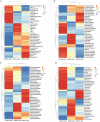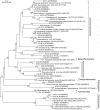Vertical stratification of bacteria and the chemical compounds in crude oil-contaminated soil layers of the semi-deserted Dzungharian Basin
- PMID: 30252862
- PMCID: PMC6155523
- DOI: 10.1371/journal.pone.0203919
Vertical stratification of bacteria and the chemical compounds in crude oil-contaminated soil layers of the semi-deserted Dzungharian Basin
Abstract
The largely semi-deserted and deserted Dzungharian Basin sites in the northwest of China geologically represent an extension of the Paleozoic Kazakhstan Block and were once part of an independent continent. For reasons of overdevelopment and unreasonable operations during the process of exploitation and transportation, oil pollutants that were discharged into the soil environment caused serious pollution in this weak ecosystem. To explore the bacterial community composition in detail and their possible origination and potential during the natural attenuation of petroleum contaminants in this type of ecologic niche, GC-MS and high-throughput sequencing techniques were used to resolve the organic compounds and bacterial communities in vertical soil layers. The degradation of petroleum contaminants in semi-deserted and deserted soils mainly occurred in the layer at a depth of 45-55 cm. During this process, aromatic and heterocyclic compounds were significantly enriched in soils. The bacterial communities in this basin exhibited a distinct vertical stratification from the surface layer down to the bottom soil layer. Considering the interaction between the community composition and the geochemical properties, we speculate that the degradation of petroleum contaminants in this semi-deserted and deserted soil might represent a microorganism-mediated process and mainly occur in the deeper soil layer.
Conflict of interest statement
The authors have declared that no competing interests exist.
Figures









Similar articles
-
[Effect of environmental factors on bacterial community structure in petroleum contaminated soil of Karamay oil field].Wei Sheng Wu Xue Bao. 2016 Aug 4;56(8):1301-13. Wei Sheng Wu Xue Bao. 2016. PMID: 29738200 Chinese.
-
Modulation of microbial consortia enriched from different polluted environments during petroleum biodegradation.Biodegradation. 2018 Apr;29(2):187-209. doi: 10.1007/s10532-018-9823-3. Epub 2018 Feb 28. Biodegradation. 2018. PMID: 29492776
-
Dynamics of indigenous bacterial communities associated with crude oil degradation in soil microcosms during nutrient-enhanced bioremediation.Waste Manag Res. 2012 Mar;30(3):225-36. doi: 10.1177/0734242X11410114. Epub 2011 Aug 8. Waste Manag Res. 2012. PMID: 21824988
-
Mycoremediation of petroleum contaminated soils: progress, prospects and perspectives.Environ Sci Process Impacts. 2019 Sep 18;21(9):1446-1458. doi: 10.1039/c9em00101h. Environ Sci Process Impacts. 2019. PMID: 31342990 Review.
-
Petroleum Hydrocarbon Contamination in Terrestrial Ecosystems-Fate and Microbial Responses.Molecules. 2019 Sep 19;24(18):3400. doi: 10.3390/molecules24183400. Molecules. 2019. PMID: 31546774 Free PMC article. Review.
References
-
- Li Y, Sharps R, McWilliams M, Li Y, Li Q, Zhang W, et al. Late Paleozoic paleomagnetic results from the Junggar block, northwestern China. J Geophys Res-Sol EA. 1991;96(B10): 16047–16060.
-
- Popov LE, Cocks RM. Late ordovician palaeogeography and the positions of the kazakh terranes through analysis of their brachiopod faunas. Acta Geologica Polonica. 2017;67(3): 323–380.
Publication types
MeSH terms
Substances
LinkOut - more resources
Full Text Sources
Other Literature Sources
Medical
Miscellaneous

